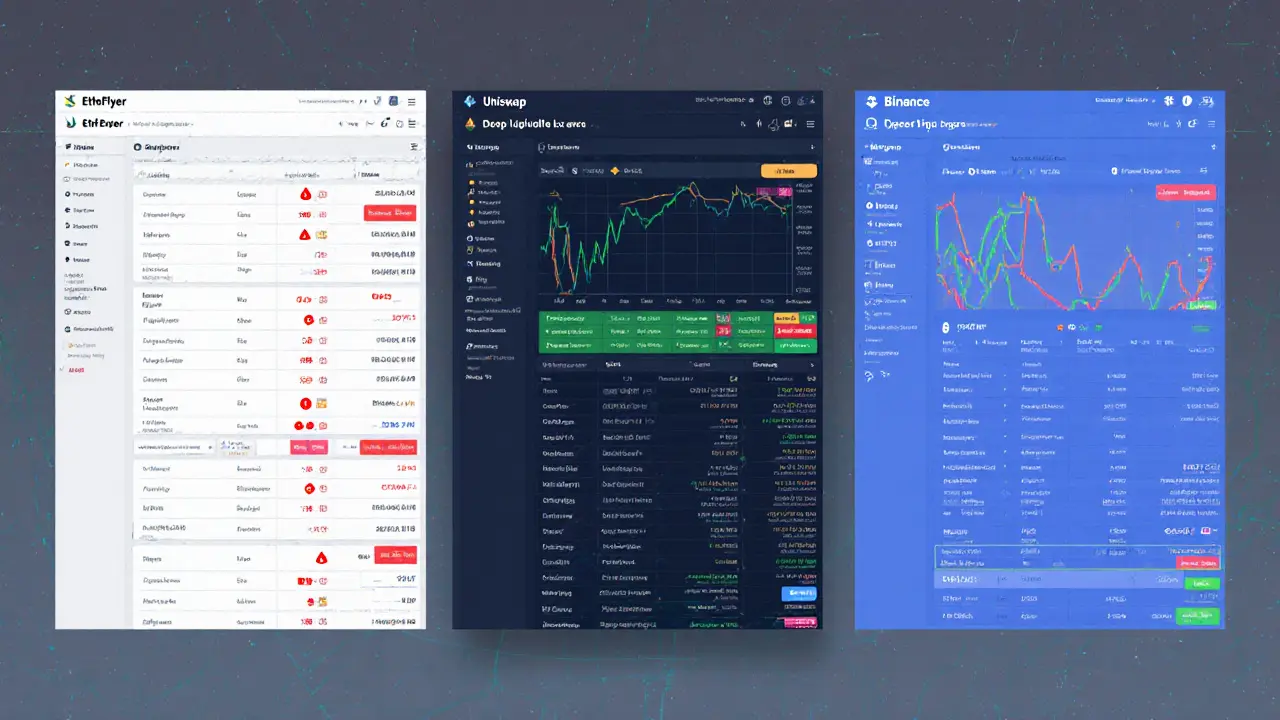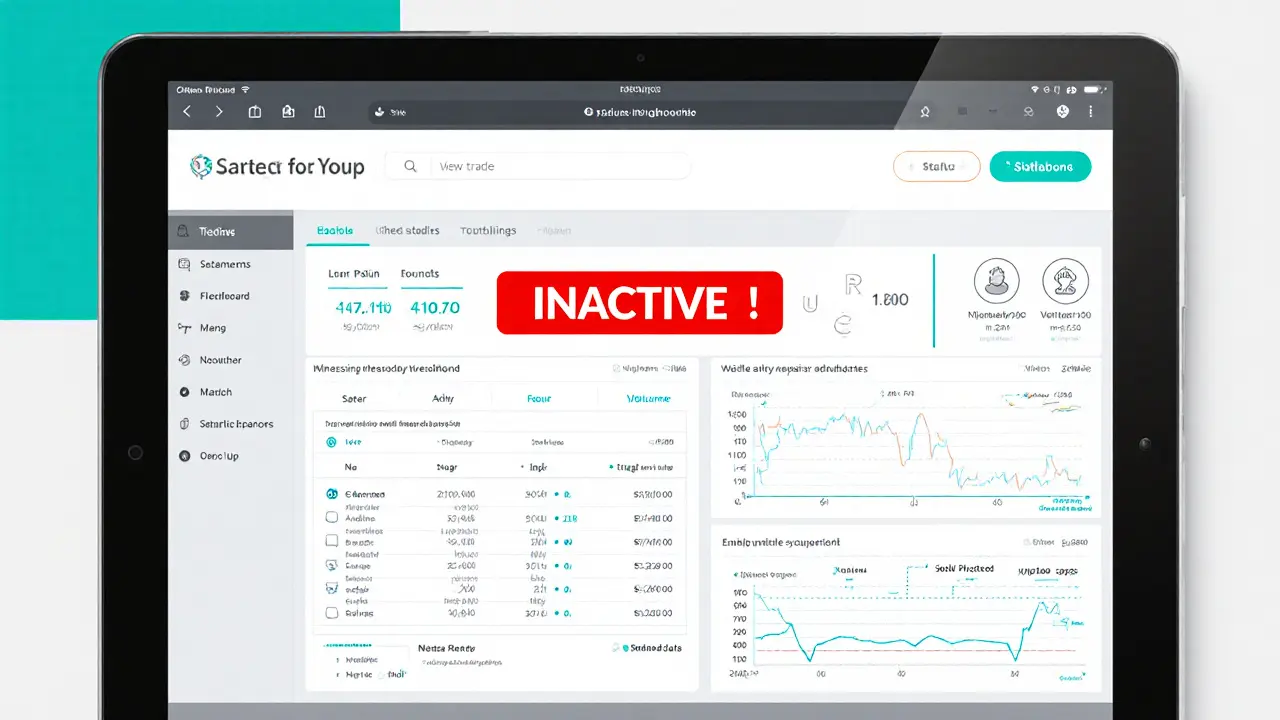EtherFlyer Exchange Status Checker
Exchange Status Overview
This tool verifies the current operational status of EtherFlyer based on publicly available data sources.
Key Indicators
- Trading Pairs None Listed
- Volume Data Untracked
- User Reviews 2 Reviews
- Active Nodes Inactive
Data Sources
- CoinMarketCap - Untracked Listing
- CoinGecko - Zero Metrics
- CoinCodex - No Longer Operational
- CryptoGeek - Minimal Reviews
Comparison Table
| Feature | EtherFlyer | Typical DEX (e.g., Uniswap) | Centralized Exchange (e.g., Binance) |
|---|---|---|---|
| Operational Status | Inactive (CoinCodex) | Active, high uptime | Active, 99.9% uptime |
| Liquidity | Untracked, effectively zero | Deep, millions of USD daily | Deep, billions of USD daily |
| User Reviews (public) | 2 reviews, 3/5 rating | Thousands of reviews, >4.5 rating | Thousands of reviews, >4.5 rating |
| Regulatory Oversight | Registered in Samoa - low oversight | Decentralized, no formal regulator | Registered in multiple jurisdictions, strict KYC |
| KYC Requirement | None reported | None | Mandatory |
| Security Model | Self-custody, but no active nodes | Self-custody, audited smart contracts | Custodial, insurance on assets |
Recommendations
Based on the current status of EtherFlyer, we recommend considering the following alternatives:
EtherFlyer is a decentralized cryptocurrency exchange registered in Samoa that launched in October 2017. It promised the usual DEX benefits - users keep full control of their funds and no KYC is required - but recent data shows it has silently disappeared from the market. This review pulls together every publicly available signal - from data aggregators to user feedback - to help you decide whether EtherFlyer is still worth a look.
Key Takeaways
- EtherFlyer is no longer operational according to CoinCodex and has no listed trading pairs.
- Major aggregators (CoinMarketCap, CoinGecko) label it an "untracked listing" with zero volume data.
- User adoption was minimal: only two public reviews on CryptoGeek, yielding a 3/5 rating.
- The platform’s Samoan registration offers lax regulatory oversight but also raises red‑flag concerns about user protection.
- For anyone seeking liquidity or reliable market data, established DEXs (Uniswap, SushiSwap) or reputable centralized exchanges are far safer choices.
Background & Launch
When EtherFlyer debuted in October 2017, the crypto world was still grappling with the concept of decentralized trading. Most exchanges were centralized, holding user assets in hot wallets and requiring extensive KYC. By positioning itself as a Samoan‑registered DEX, EtherFlyer aimed to capture traders who wanted anonymity and control. At the time, Samoa’s relatively permissive stance on digital assets made it an attractive jurisdiction for crypto startups seeking to avoid stricter oversight in Europe or the United States.
Early marketing highlighted “global access, no personal data, and peer‑to‑peer order matching”. In theory, these promises matched the core definition of a Decentralized Exchange a platform where trades occur directly between users without a central custodian. However, the promise alone is not enough - a DEX still needs visible liquidity, an active order book, and transparent metrics to attract traders.
Transparency & Data Issues
Transparency is the lifeblood of any exchange. Users need to see volume, order depth, and supported pairs before committing capital. EtherFlyer failed at every data point.
As of September 20, 2021, CoinMarketCap listed EtherFlyer as an "untracked listing" - meaning it could not retrieve any daily volume or pair information. CoinGecko mirrored this silence, providing zero metrics for the exchange.
The lack of data is more than a minor inconvenience; it’s a red flag. Without observable liquidity, a trader cannot gauge slippage risk or confirm that orders will fill. The platform’s own site never published a public API for volume stats, and third‑party aggregators could not scrape any figures.
User Experience & Reviews
Community sentiment is another barometer of health. CryptoGeek, a niche review aggregator, recorded only two user reviews for EtherFlyer, resulting in a 3‑out‑of‑5‑star rating. One review on AffGadgets praised the platform as “efficient” and “quick”, but that single voice sits against a backdrop of essentially no feedback. Forex Peace Army reported zero reviews as of November 2024.
Such sparse engagement suggests two possibilities: either the platform never attracted enough traders, or users abandoned it early on. Either way, the lack of a vibrant community makes it hard to troubleshoot issues, share best practices, or benefit from collective liquidity.

Regulatory & Jurisdiction Factors
Operating from Samoa gave EtherFlyer a regulatory cushion. The Samoan Financial Services Authority has historically taken a hands‑off approach to crypto, allowing startups to launch without extensive licensing. However, this lax environment also means there is little consumer protection if something goes wrong.
Importantly, EtherFlyer’s terms did not list the United States as a prohibited country. Reviewers cautioned U.S. residents to perform their own legal assessment because U.S. crypto regulation is fragmented across federal and state levels. The absence of a clear “no U.S. persons” clause adds uncertainty for traders who must navigate AML and securities laws on their own.
Current Operational Status
Recent checks on CoinCodex now show the exchange as “no longer operational”. The site cannot display any trading pairs or volume data, and attempts to load the platform’s front‑end result in a dead link. No roadmap, development updates, or community announcements have appeared since late 2022.
In the fast‑moving crypto space, an exchange that disappears silently is effectively dead. Even if the codebase were still hosted on a public repository, without active nodes and liquidity providers the DEX cannot function.
Should You Trade on EtherFlyer?
Short answer: no. The platform offers none of the essential criteria that traders look for - measurable liquidity, an active user base, transparent fee structures, and reliable uptime.
If you value the core DEX principles of self‑custody and privacy, consider alternatives that still thrive:
- Uniswap (V4) - the leading Ethereum DEX with deep liquidity and robust analytics.
- SushiSwap - offers similar features plus yield farming incentives.
- 1inch - aggregates liquidity across multiple DEXs for best price execution.
For those who prefer centralized services - where order books, KYC, and customer support are guaranteed - exchanges like Binance, Kraken, and Coinbase remain the industry standards.
Quick Comparison Table
| Feature | EtherFlyer | Typical DEX (e.g., Uniswap) | Centralized Exchange (e.g., Binance) |
|---|---|---|---|
| Operational Status | Inactive (CoinCodex) | Active, high uptime | Active, 99.9% uptime |
| Liquidity | Untracked, effectively zero | Deep, millions of USD daily | Deep, billions of USD daily |
| User Reviews (public) | 2 reviews, 3/5 rating | Thousands of reviews, >4.5 rating | Thousands of reviews, >4.5 rating |
| Regulatory Oversight | Registered in Samoa - low oversight | Decentralized, no formal regulator | Registered in multiple jurisdictions, strict KYC |
| KYC Requirement | None reported | None | Mandatory |
| Security Model | Self‑custody, but no active nodes | Self‑custody, audited smart contracts | Custodial, insurance on assets |
Next Steps & Troubleshooting
If you accidentally tried to connect a wallet to EtherFlyer and found the site down, the safest move is to disconnect the wallet and move any assets to a reputable wallet (e.g., MetaMask) or a trusted exchange. Since the DEX is inactive, there’s no risk of loss from the platform itself, but always double‑check that you haven’t approved any lingering smart‑contract permissions that could be exploited elsewhere.
Should you discover an old EtherFlyer smart‑contract address still on the blockchain, you can verify its status via Etherscan. Look for recent transaction activity; a dormant contract will show no interactions for months. Revoking any token allowances you may have granted through a tool like Revoke.cash adds an extra layer of safety.

Frequently Asked Questions
Is EtherFlyer still usable in 2025?
No. CoinCodex lists the exchange as "no longer operational" and the website no longer loads. There is no way to place trades or view order books.
Can I still retrieve funds I deposited on EtherFlyer?
Because EtherFlyer was a non‑custodial DEX, you never handed over private keys to the platform. Your assets remain in your wallet unless you manually sent them to a contract address that is now inactive. If you did send tokens to an EtherFlyer contract, you can try to withdraw via the original contract UI (if it still works) or use a blockchain explorer to interact directly, but success is unlikely.
Why is there no trading volume data for EtherFlyer?
Data aggregators like CoinMarketCap and CoinGecko rely on public APIs or blockchain analytics to calculate volume. EtherFlyer never exposed an API and its on‑chain activity was too low to generate measurable volume, so the platforms flagged it as "untracked".
Are there any red flags that should deter me from using similar DEXs?
Key red flags include: no visible liquidity, no public audit reports, zero user reviews, and lack of transparent ownership or jurisdiction information. Always check multiple data sources before committing capital.
What alternatives should I consider for decentralized trading?
Uniswap V4, SushiSwap, 1inch, and Curve are the most popular DEXs with robust liquidity, audited contracts, and active community support. They also provide clear analytics on volume and price impact.

